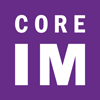Core IM
How can language contribute to increasing or decreasing the stigma surrounding OUD? In this episode of Core IM, the team will discuss this challenge as well as physicians’ potential lack of ability to apply culturally relevant approaches to SUD treatment and management. The need for understanding the spectrum of substance use, and more, is covered 5 Pearls on Stigma in Opioid Use Disorder.
First, listen to the podcast. After listening, ACP members can take the CME/MOC quiz for free.
CME/MOC:
Up to 1
AMA PRA Category 1 Credits ™ and MOC Points
Expires September 29, 2024
active
Cost:
Free to Members
Format:
Podcasts and Audio Content
Product:
Core IM
Welcome to Core IM, a virtual medical community! Core IM strives to empower its colleagues of all levels and backgrounds with clinically applicable information as well as inspire curiosity and critical thinking. Core IM promotes its mission through podcasts and other multimodal dialogues. ACP has teamed up with Core IM to offer continuing medical education, available exclusively to ACP members by completing the CME/MOC quiz.

Pearl 1: Starting the conversation
- Start by working to earn the patient’s trust
- Prior trauma and negative experiences in healthcare settings are common in patients with SUD
- Taking withdrawal seriously and treating it effectively can earn trust and communicate the patient’s needs are a priority
- Here is a helpful guide. And more tools here.
- You might have an inpatient addiction team who can help you with this!
- Aggressively treat pain! It’s ok to use full-agonist opioids for pain and partial agonists (i.e. buprenorphine) to manage withdrawal
- Ask about SUD as you would another medical condition
- If patient is hesitant or resistant to answering questions can ask permission to help earn trust
- Use person-first language
- Randomized controlled trials have shown that labeling a patient as a “person with substance use disorder” instead of “substance abuser” correlates to recommending more treatment and less blame or punishment by healthcare providers
- Non-stigmatizing, non-judgmental, medically based language can improve patient access and engagement in care.
- Avoiding stigmatizing language
- Refer to urine drug tests as “positive” or “negative” if they reflect presence or absence of substance, respectively. Avoid labeling them as “clean” or “dirty”
Pearl 2: The Shared Agenda
- The goals of a substance use history are to learn about your patient’s drug use, look for opportunities to reduce harm in use, and inquire about their goals
- Remember that not all drug use qualifies a person for a substance use disorder.
- Basic substance use narrative:
- What drugs are they using?
- How are they using (i.e. route of administration - inhalation, intranasal, intravenous?)
- For how long have they been using?
- Was there a point when their use started causing problems?
- Listen for ways the substance use has negatively impacted their lives or caused distress in order to diagnose them with a substance use disorder (DSM-V criteria).
- Treatment history:
- Building on past successes with medications or types of behavioral therapies can guide the treatment plan.
Pearl 3: Exploring the patient’s goals
- This sounds obvious, but the patient’s goal is really the goal that matters!
- That might mean that stopping drug use is NOT the goal… that’s OK
- Transtheoretical Model of Behavior Change or “Stages of Change” may have some pitfalls if we’re not careful
- May distract us from the patient’s goal
- May tempt us to judge or blame patient for not changing if we label someone as “pre-contemplative”
- May cause us not to offer treatment such as harm reduction if patient labeled as “pre-contemplative”
- In helping patients identify their own goals you can refer back to past successes or hints to what the patient’s priorities are
Pearl 4: For the patient goal of reducing drug use
- Run with the momentum, don’t explain to patients what they already know
- Connect patients to MOUD (Medications of Opioid Use Disorder): buprenorphine +/- naloxone, methadone, long-acting injectable naltrexone
- Term “MAT” is moving to “MOUD” to center medications in treatment
- Evidence-based benefits:
- Buprenorphine has better in-hospital outcomes than detox
- MOUD all reduce mortality
- Patient-centered choice of MOUD: one example of a good patient-centered resource is shatterproof.org
- Psychosocial treatment and recovery support are also key
- Evidence of additional benefit when added to MOUD, though variable by intervention style
- Don’t withhold MOUD if patients are reluctant to engage in psychosocial treatments
- Recovery support is an umbrella term and includes different groups and peer coaching
Pearl 5: Reducing harm in substance use
- Make it clear to your patient that ongoing drug use does not preclude access to medical care
- Emphasizing patient’s safety in drug use
- Ask about naloxone, prescribe/supply if pt interested
- Fentanyl test strips allow patients to detect fentanyl in unregulated drugs
- Clean needles, needle disposal/exchange: good websites that search by location include harmreduction.org, NASEN website (North American Syringe Exchange Network)
Contributors
Martin Fried, MD - Editor, Host
Alexis Vien, MD - Editor, Host
Jon Avery, MD - Guest
Laura Kolbe, MD - Editor, Host
Sarah Wakeman, MD - Guest
Reviewers
Jessica L. Taylor, MD
Margaret (Peggy) Williams, MD
None of the individuals in control of content for this educational activity have relevant financial relationship(s) to disclose with ineligible companies whose primary business is producing, marketing, selling, re-selling, or distributing healthcare products used by or on patients.
Release Date: September 29, 2021
Expiration Date: September 29, 2024
CME Credit
This activity has been planned and implemented in accordance with the accreditation requirements and policies of the Accreditation Council for Continuing Medical Education (ACCME) through the joint providership of the American College of Physicians and the Core IM. The American College of Physicians is accredited by the ACCME to provide continuing medical education for physicians.
The American College of Physicians designates each enduring material (podcast) for 1 AMA PRA Category 1 Credit™. Physicians should claim only the credit commensurate with the extent of their participation in the activity.
ABIM Maintenance of Certification (MOC) Points
Successful completion of this CME activity, which includes participation in the evaluation component, enables the participant to earn up to 1 medical knowledge MOC Point in the American Board of Internal Medicine’s (ABIM) Maintenance of Certification (MOC) program. Participants will earn MOC points equivalent to the amount of CME credits claimed for the activity. It is the CME activity provider’s responsibility to submit participant completion information to ACCME for the purpose of granting ABIM MOC credit.
How to Claim CME Credit and MOC Points
After listening to the podcast, complete a brief multiple-choice question quiz. To claim CME credit and MOC points you must achieve a minimum passing score of 66%. You may take the quiz multiple times to achieve a passing score.


